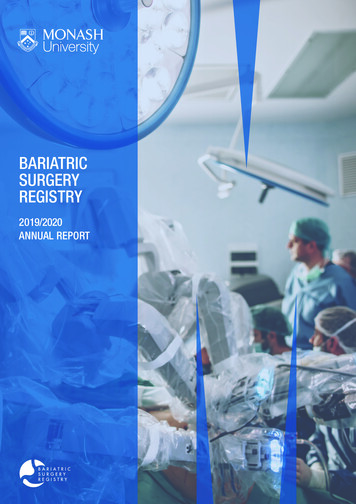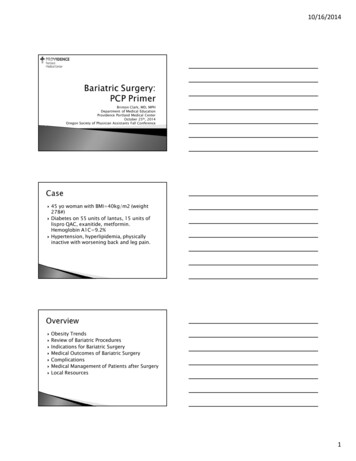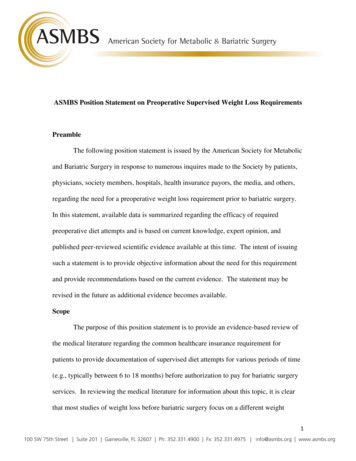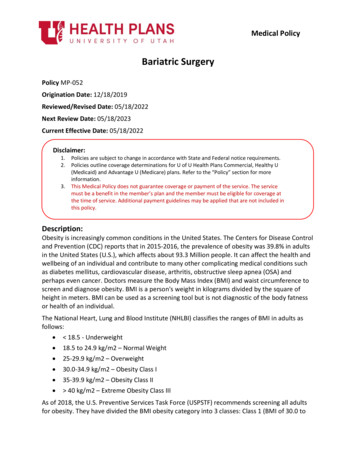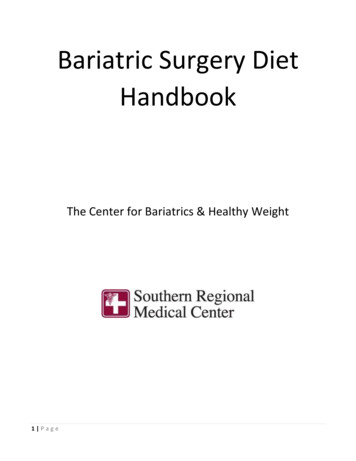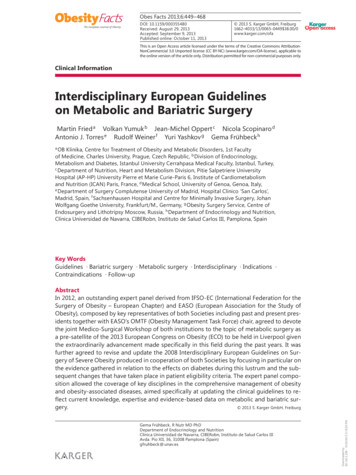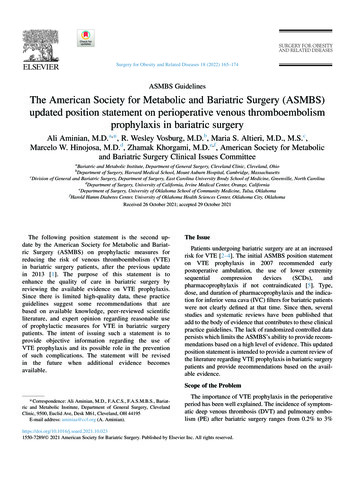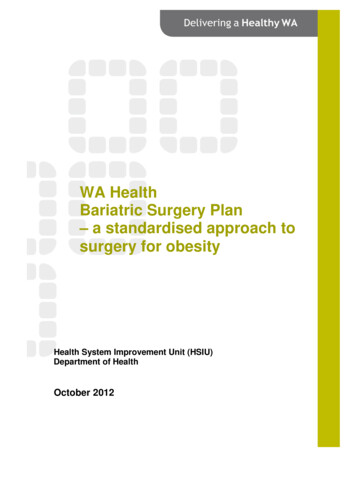
Transcription
ClinicalWA HealthBariatric Surgery Plan– a standardised approach tosurgery for obesityHealth System Improvement Unit (HSIU)Department of HealthOctober 2012
WA Health Bariatric Surgery Plan – a standardised approach to surgery for obesity – October 2012ContentsContents . 2Abbreviations . 3Tables and Figures . 4Scope. 5Strategies . 6Introduction . 6Current Status . 7Morbid Obesity Model of Care . 8Assessing interventions for obesity . 9Surgical and non-surgical interventions. 9Comparison of surgical procedures . 10Weight loss surgery in Australia . 11Discussion .12New South Wales . 13England . 13WA Policy Inconsistencies .13Access criteria . 13Nominated Hospital Setting . 15Financial Implications . 15Obesity Classification . 15References.19Related material .21Bibliography .212
WA Health Bariatric Surgery Plan – a standardised approach to surgery for obesity – October 2012AbbreviationsActivity Based Funding and ManagementABF/MAdjustable gastric bandAGBAustralian Institute of Health and WelfareAIHWBody mass indexBMIDepartment of HealthDoHDepartment of Veteran’s AffairsDVADiagnostic Related GroupDRGElective Surgery Wait ListESWLElective and Emergency Steering CommitteeEESCFremantle Hospital and Health ServiceFHHSGeneral practiceGPLaparoscopic adjustable gastric bandingLAGBHealth System Improvement UnitHSIUIntensive Care UnitICULaparoscopic Roux-en-Y gastric bypassLRYGBModel of CareMoCNational Health and Medical Research CouncilNHMRCNational Partnership AgreementNPANorth Metropolitan Health ServiceNMHSOperational DirectiveODPerformance Activity and QualityPAQReady for CareRFCRoux-en-Y gastric bypassRGBRoyal Perth HospitalRPHSir Chares Gairdner HospitalSCGHState Health Executive ForumSHEFSouth Area Health ServiceSMHSVery low calorie dietVLCDWestern AustraliaWA3
WA Health Bariatric Surgery Plan – a standardised approach to surgery for obesity – October 2012Tables and FiguresFiguresTitlePageFigure 16Figure 5WA State summary, quarterly admissions,September 2006 quarter - December 2011 quarterWA State summary, cases waiting & proportion (%)within boundary, September 2006 quarter December 2011 quarterNSW Health Recommended Criteria for Eligibilityfor Bariatric SurgeryNational Institute for Health and Clinical Excellence(NICE) Overweight /Obesity Management PathwayWA Bariatric Assessment CriteriaTablesTitlePage5Table 6Separations for bariatric procedures in public andprivate hospitalsCounts overboundary bariatric cases at 31 January2011and 2012Percentage excess body weight loss after bariatricsurgeryImprovement of co-morbidities after surgical bariatricproceduresMortality and morbidity after laparoscopic bariatricproceduresClassification of obesity by BMITable 7Classification of obesity by waist circumference16Table 8Interventions for obesity by BMI and waistcircumference16Figure 2Figure 3Figure 4Table 1Table 2Table 3Table 4Table 571417188111111164
WA Health Bariatric Surgery Plan – a standardised approach to surgery for obesity – October 2012ScopeThe purpose of this Bariatric Surgery Plan is to provide an overview of obesityin the context of elective surgery, the identified issues and proposed strategiesto improve the care co-ordination and management of these patients.The State Health Executive Forum (SHEF) considered the efficacy of surgicalprocedures for obesity, and the situation of the bariatric cohort on the electivesurgery waitlist (ESWL) in January 2011.There is compelling support for focused attention on obesity. Results from theNational Health Survey (2007-08) showed that “25% of persons aged 18 yearsand over to be obese, 37% overweight, 37% normal weight and 2%underweight. The highest rate of overweight/obesity was in the 65-74 year agegroup, at 75%. More adult males (68%) were overweight or obese than adultfemales (55%)” (1).The Australian Chronic Disease Prevention Alliance Chairperson, ProfessorOlver said “Obesity is now overtaking tobacco as the largest preventablecause of disease in Australia. Obesity already affects nearly four millionAustralians and costs 58 billion. Unless we get serious about prevention,nearly seven million Australians will be obese by 2025” (2).From a Western Australian perspective, ‘The burden of disease and injuryattributed to preventable risks to health in Western Australia -2006, publishedin 2010 found that excess body weight (overweight and obesity) was theleading cause of disease burden (premature death and disability combined).“High body mass ranked as the highest contributor to disease burden,accounting for 8.7% of the total burden of disease and injury in WA in 2006.High body mass contributed 2.2% more to the total burden than the nextleading risk factor, tobacco (6.5%)” (p.4) (3).The WA Chief Health Officer’s Report (2010) outlined that: “Trends in lifeexpectancy show a continuing improvement over time . but furtherimprovements will be harder to achieve (‘the law of diminishing returns’) andthere are new threats, such as rising levels of obesity, that might lead toreversal of some gains in future generations” (4).Table 1 below outlines the increase in bariatric surgery in WA over the past sixyears. The Private sector provides the majority of separations, with the shareprovided in the public sector increasing to 21.7% in 2010/11.Table 1. Separations for bariatric procedures in public and private hospitalsYearPublic sep'nsPrivate sep'nsPublic %2010-117133,28221.7%5
WA Health Bariatric Surgery Plan – a standardised approach to surgery for obesity – October 2012StrategiesAn Operational Directive for elective bariatric surgery will be developedconsistent with the approaches taken in England and New South Wales.1. Develop and promote an evidence based assessment and care pathwayfor the appropriate management of obesity to support general practice asthe ‘case manager’ for the patient / family, utilising the Enhanced PrimaryCare Medicare funded items of allied health (five visits per annum) andpsychological support (ten visits per annum), with appropriate referralpoints to specialist care.2. Develop standardised access criteria for bariatric surgery and establishthis as a state-wide policy for all public hospitals providing bariatric surgicalintervention.3. Develop state-wide policy that all uncomplicated elective bariatricprocedures are classified as Category 3.4. WA Health has determined that Joondalup Health Campus will become thestatewide provider for bariatric surgery. Cases requiring tertiary level carewill be referred to Sir Charles Gairdner Hospital.IntroductionOver the past five years WA Health has made significant improvements in themanagement of elective surgery, with a higher proportion of patients withinboundary across the state.Figure 1. WA State summary, quarterly admissions, September 2006 quarter December 2011 quarter.Note: extracted from Western Australian Elective Surgery Wait List (ESWL) Report December2011 Quarter (4)6
WA Health Bariatric Surgery Plan – a standardised approach to surgery for obesity – October 2012Figure 2. WA State summary, cases waiting & proportion (%) within boundary,September 2006 quarter - December 2011 quarterNote: extracted from Western Australian Elective Surgery Wait List (ESWL) Report December2011 Quarter (4)During the same period, WA Health has continued to experience increaseddemand for elective surgery. Specialities such as orthopaedic surgery andgeneral surgery remain the largest patient cohorts on the Elective Surgery WaitList (ESWL). Bariatric procedures to address obesity are included in thesurgical specialities of general surgery and plastic surgery.While the National performance measures from the Australian Institute ofHealth and Welfare (AIHW) focus on median waiting time for each category,and performance has continually improved, the particular issues with longerthan clinically desirable waiting times for people awaiting bariatric surgery wasconsiderably understated.Following the Expert Panel Review of elective surgery nationally in 2011, thetargets set by the National Partnership Agreement (NPA) from 2012 -2014changed (5). With the shift to average or ‘mean’ measures and targets with anincremental reduction in the mean days’ overboundary for each category(2012-2014), the long wait cases become immediately apparent. Thismeasure coupled with the mandatory requirement to address the ten per centlongest wait cases or the ‘tail’ for each category, has emphasised the issue ofextended wait times for bariatric surgery.Current StatusIn January 2011, WA Health considered the demand for bariatric surgery atSHEF. At that time data was provided to outline the types of procedures,category and wait times. It is noted that in January 2012 there were 473bariatric cases on the ESWL, this has reduced to 390 (by 17.5%)predominantly because the cases have been determined not ready for care, asopposed to being completed. Table 2 shows the overboundary bariatric casesby procedure.7
WA Health Bariatric Surgery Plan – a standardised approach to surgery for obesity – October 2012Table 2: Counts overboundary bariatric cases at 31 January 2011and 2012Procedure descriptionLipectomy of abdominal apron*Gastric reduction2011Long Wait182012Long Wait189Revision Gastric band6Laparoscopic gastric reduction4765Reduction mammoplasty, bilateral*5867Others1521Total147193Notes: * Includes a principle diagnosis of adiposity or obesity/morbid obesity (E65 or E66.0 E66.9). The grouping ‘others’ includes procedures for which there were less than 5 patientsand have therefore been combined for confidentiality reasons.Morbid Obesity Model of CareThe WA Health Networks published the Morbid Obesity Model of Care (MoC)in 2008 (6). This is WA’s broad policy statement similar to the New SouthWales Obesity Management Plan (7). In relation to surgical intervention, theWA MoC makes the following key points: That, “availability and delivery of bariatric surgery in the public healthsystem in Australia is inconsistent” (p.23);One to two years after surgery, morbidly obese patients can lose 1643% (22-63 kg) of body weight, which can be maintained with asupervised weight management plan (p.23). Research identified thatthere are a range of surgical guidelines that are currently available forthe treatment of the morbidly obese; andThe Obesity Surgery Society of Australia and New Zealand provideselection criteria for bariatric surgery. Area Health Services have policyguidelines on all surgical procedures for the morbidly obese. However,these guidelines vary across WA, along with facilities. There needs tobe an integrated approach towards adopting available guidelines (p.23).The recommendations outlined in the MoC in relation to surgical interventionincluded: All gastric surgery should be performed by an appropriately credentialedsurgeon with access to specialised accredited peri-operative support(p.25);Promote state wide implementation of surgical guidelines, endorsed bycredentialed professional bodies, for the treatment of the morbidlyobese (p.25); andHospital/Health service policy should include specialised services andfacilities to manage morbid obesity in a dignified manner (p.26).The MoC noted that, “Some insurance and government agents havequestioned the cost effectiveness of bariatric surgery. However, a number ofstudies have found in relation to hospital, pharmaceutical and physician costs,bariatric surgery is a cost-saving procedure to health care and governmentalagencies after the first few years of surgery” (p28).8
WA Health Bariatric Surgery Plan – a standardised approach to surgery for obesity – October 2012Assessing interventions for obesitySurgical and non-surgical interventionsThere is a substantial body of evidence suggesting that bariatric surgery iscurrently the only intervention that consistently results in substantial, sustainedweight loss in morbidly obese patients (over 40 BMI or between 35 and 40with significant comorbidities). Surgery has also been shown to have a positiveimpact on diabetes and cardiovascular risk and reduce mortality moreeffectively compared to conventional obesity treatments (8).While surgery has promising outcomes against several measures, it is alsoconsistently argued that a multidisciplinary approach is required. The efficacyof various procedures and the wider use of surgical interventions for treatingobesity (as opposed to morbid obesity) continues to be debated in theliterature.The Swedish Obese Subjects (2007) is a landmark and highly cited studyconducted over more than 10 years examining “conventional” versus surgicalinterventions. Key points regarding this study are as follows: Conventional therapies included dietary education, pharmaceuticaltherapies;The surgical group included banding, vertical banded gastroplasty andbypass;Mean weight for the non-surgical group changed little, with a slight lossfollowed by slight gain then plateauing up to the 10 year mark;Mean weight for surgical cohorts dropped dramatically and thenincreased steadily, with banding group continuing to increase throughthe study; andInitial mortality was slightly higher for surgical group, with final resultsshowing mortality was substantially higher in the conventional therapygroup (8).Over the shorter term, non-surgical interventions have been found to beeffective weight reduction strategies for severe or morbid obesity. A NationalHealth and Medical Research Council (NHMRC) report indicates mean %weight loss over 4-20 weeks for different weight loss methods.Over this shorter time frame a very low calorie diet (VLCD) supplemented withOptifast achieved 14.7% weight loss, second only to surgical intervention (2438%). One study has showed that patients using a VLCD prior to surgery hadbetter compliance outcomes post-operatively.Pharmaceutical treatments that are currently available are limited both innumber and efficacy (9). Orlistat, which prevents the absorption of fat, wasvery popular when initially marketed in 2007 but has since waned with onereport indicating rates of less than 10% at one year and 2% at two years.Sibutramine (Reductil) belongs to a class of selective serotonin andnoradrenalin reuptake inhibitors, and in 2010 was withdrawn in Australia andother countries due to reported increase in cardiovascular risks.9
WA Health Bariatric Surgery Plan – a standardised approach to surgery for obesity – October 2012Surgery has previously been recommended only for severely or morbidlyobese patients. There is research emerging to suggest that surgery may beappropriate for those with a BMI of over 35 with no comorbidites, or between30 and 35 with significant comorbidities.Comparison of surgical proceduresLaparoscopic adjustable gastric banding (LAGB) and Laparoscopic Roux-en-Ygastric bypass (LRYGB) are two of the most commonly performed proceduresin the treatment of morbid obesity in Australia.The perioperative costs associated with bariatric surgery exceeds nonsurgicaltreatments (9). However, effective surgery may reduce the costs associatedwith medication use, outpatient visits and hospitalisation over time.The efficacy of treatments for morbid obesity may be measured by a number ofindices, including: Weight loss – absolute; BMI; % excess weight loss;Comorbidities – type 2 diabetes; hyperlipidaemia, hypertension, sleepapnoea; andMortality – as a result of surgical complications versus long term chronichealth conditions associated with obesity (9 & 10).The positive impacts of bariatric surgery on other factors such as metabolism(i.e. post-operative improvement in insulin resistance) and psychosocial status(improvement in mood, depression) have also been assessed by researchers.In general it is reported that LRYGB (i.e. bypass) more consistently achievesbetter weight loss results, over the longer term, and a reduced number ofsurgical failures compared with LAGB (i.e. banding) (11). Some studies haveshown that a higher proportion of patients have more frequent positive impacton associated comorbidities (i.e. type 2 diabetes) than with banding. There area number of post-operative complications associated with banding proceduresincluding slippage and irritation caused by the band, and pouch dilations (11).This has led to the need to convert banding to a bypass or other permanentsurgical procedure. LRYGB however also has a significantly longer operatingand recovery time and increased incidents of life-threatening complications.A broad literature review conducted in 2009 compares the efficacy andmorbidity associated with various surgical procedures. The tables below areextracted from the literature review and give a comparison between bypassand banding (11).Table 3 below shows a comparison of mean excess weight loss betweensurgical procedures. RGB surgery has noticeably higher percentage of weightloss in the first year, but the difference between procedures becomes smallerover time.10
WA Health Bariatric Surgery Plan – a standardised approach to surgery for obesity – October 2012Table 3. Percentage excess body weight loss after bariatric surgeryRGB Roux-en-Y gastric bypass; AGB Adjustable gastric bandNote: table extracted from Boza et al (11)Table 4 shows the impact of surgery on comorbidities, with RGB surgeryshowing a great impact on comorbidities over banding, except for sleepapnoea.Table 4. Improvement of co-morbidities after surgical bariatric proceduresNote: table extracted from Boza et al (11)Table 5 shows the percentage of mortality at 30 days, overall complicationsand major complications, with the lowest percentage for each beingassociated with banding.Table 5. Mortality and morbidity after laparoscopic bariatric proceduresNote: table extracted from Boza et al (11)In summary, the review indicates that there is a relationship between thecomplexity, effectiveness and risk related to the type of surgery (12 &13). Thatis, surgery that is more effective in terms of weight loss also tends to be morecomplex and have the highest risk of complication (e.g. bypass), while thoseoffering greater safety and flexibility may be less effective (e.g. banding). Thisappears to extend to non-surgical interventions, which have a lowest potentialfor related complications, but also with the least potential for long termsubstantial weight loss in patients with severe or morbid obesity.It appears that there is no clear indication regarding the ‘best’ form of bariatricsurgery and that there are a range of factors to be taken into consideration indetermining the most appropriate intervention in any given situation.Weight loss surgery in AustraliaIn 2010 the AIHW published Weight loss surgery in Australia (14) a detailedreport providing, ‘a comprehensive range of statistical information on weightloss surgery, obesity prevalence and general practitioner services for peoplewith excess body weight’ (p. ii). The report acknowledges the Government11
WA Health Bariatric Surgery Plan – a standardised approach to surgery for obesity – October 2012inquiry into Obesity in Australia (2009), with recommendations for theprevention and management of the increasing obesity problem.Recommendations included: To ensure equity in access by publicly funding bariatric surgery,including multidisciplinary support teams, for those patients that meetappropriate clinical guidelines (Recommendation 5).To develop a national register of bariatric surgery with appropriatestakeholders. The purpose of the register would be to capture data onthe number of patients, the success of surgeons, and any possiblecomplications. The data would be used to track the long term successand cost effectiveness of bariatric surgery (Recommendation 6) (p.1).The WA State Health Executive Forum (SHEF) has considered the efficacy ofsurgical procedures for obesity over the past two years. It is evident that workis progressing in other jurisdictions to address the obesity problem, includingsurgical options where this is deemed to be clinically appropriate.DiscussionThe WA Health Networks Morbid Obesity MoC (6), recommendations included: Comprehensive primary care strategies for the management of morbidobesityThe role of General Practice (GP) in the care of the morbidly obeseSurgical interventions for treatmentHealth care services equipment and facility issues/initiatives (p.14).To improve access to a range of services specifically for morbid obesity,multidisciplinary clinics should be in a location more accessible to more of thecommunity (p.18). The model acknowledges the key role of GP in managingpatients in the primary care setting and that the reference guide for primarycare was the NHMRC’s Clinical practice guidelines for the management ofoverweight and obesity in children and adolescents, and adults (p.22).Multi-disciplinary care in the management of obesity in primary care haspotentially been enhanced through Medicare billable services through theEnhanced Primary Care initiative (five consults per annum) and access topsychological services (ten consults per annum). This approach aligns withWA Health’s desire to increase the share of outpatient type serviceslegitimately costed to Medicare.There is evidence that other states in Australia have developed andimplemented comprehensive obesity strategies in an effort to reduce theburden of disease resulting from obesity. The Australian New Zealand ObesitySociety (October 2011) acknowledged the concerted effort being appliedthrough policy and action in Queensland and New South Wales. The Societyawarded Queensland the gold medal for action towards addressing obesity forthe third time in four years. “The key to Queensland’s success lies in itscoordinated approach through the Q2 strategy, which includes obesity targets12
WA Health Bariatric Surgery Plan – a standardised approach to surgery for obesity – October 2012for Queenslanders, and it also benefits from the strong partnerships that exitbetween various levels and sectors of government and non-governmentorganisations” (15).New South WalesWithin a broad obesity management strategy, New South Wales (NSW) havedeveloped an Obesity Management Plan in 2009 (7) to ensure that people withproblems of obesity are managed across a co-ordinated care pathway,including the option of bariatric surgery. This document is similar to the WAMoC, identifying the high risk groups and the burden of co-morbidities as aresult of obesity, the impact this has on the quality of life of individuals and thecost to the health system.The appendices of this plan include a range of resources and templates toenable health services to commence obesity management services. Thesedocuments are an excellent resource for developing similar processes for WA.EnglandThe National Health Service’ National Institute for Health and ClinicalExcellence (NICE) has published the guideline: Obesity: guidance on theprevention, identification, assessment and management of overweight andobesity in adults and children (2006) (17). The guideline takes a whole of lifeapproach and considers social determinants and lifestyle influences / healthybehaviours to address weight management. The NSW Obesity ManagementPlan is consistent with the NICE guideline.WA Policy InconsistenciesAccess criteriaThe MoC for Morbid Obesity noted the inconsistency of surgical proceduresundertaken at the various hospitals across WA, and range of access criteriaapplied for surgical intervention. Through this review it is recommended thatthe access criteria documented in the NSW Obesity Management Plan (7) isadopted by WA to standardise access to publicly funded surgical interventions.The access criteria are outlined in Figure 3.13
WA Health Bariatric Surgery Plan – a standardised approach to surgery for obesity – October 2012Figure 3. NSW Health Recommended Criteria for Eligibility for BariatricSurgery (p.51)ParameterCriteriaAge Age between 16-55 years Pregnancy not anticipated in first two years post-opBody weight BMI 40, or BMI 35 with associated obesity illnesses such as Type IIDiabetes and Sleep Apnoea Pubertal development stage 4.Resistantobesity Failed weight loss techniques including dietary, exercise andbehaviour modification programmes supervised within theBariatric ProgrammeMorbidity Obesity related morbidity as follows: diabetes, sleep apnoea,degenerative major weight bearing joint disease (and becandidate for joint replacement) etc Free of end organ damage Absence of other medical conditions such as MultipleSclerosis that would increase the morbidity or mortality riskof bariatric surgery Comprehensively assessed as fit for surgery by specialistphysician, endocrinologist, anaesthetist and bariatricsurgeonPsychologicalprofile Undergone comprehensive psychosocial evaluation, andfree of psychiatric issues, treatment or drug dependencyproblems Proven to be able to comply with and adhere to thebehavioural changes required after surgery Capacity to understand the associated risks and commitment Well-informed, motivated and with acceptable operative risks14
WA Health Bariatric Surgery Plan – a standardised approach to surgery for obesity – October 2012Nominated Hospital SettingIn allocating the category for surgery, surgeons need to ensure that the patientrecord includes the patient’s co-morbidities and clearly identifies theappropriateness of the case being completed at a general hospital or by aprivate provider. Consideration should be given to the less complex casesproactively being listed and completed outside the hospitals were emergentwork impacts on elective activity. If the patient’s clinical condition necessitatesaccess to ICU, this needs to be clearly documented. It is noted that only 2.4%of separations (n 95) in 2010/11 required ICU admission, with a total of 177ICU days utilised.A review the NSW approach to surgical planning, Surgical Futures – a plan forGreater Sydney (2011) (19), consideration has been given to developingdesignated bariatric surgery facilities to foster centres of excellence whichbetter meet the needs of the client cohort.Financial ImplicationsThe hospital where surgical procedures are performed impacts on the cost ofthe procedure under activity based funding and management. Tertiary, nonteaching and rural facilities have different prices by DRG. The sameprocedure could be completed in a more cost effective and clinicallyappropriate environment at a general, regional or private hospital.The Australian Institute of Health and Welfare (AIHW) report (14) identifiesthat, ‘in 2007-08 year 90% of weight loss surgery occurred in private hospitalswith private health insurance funding 82% of separations’ (p. viii). Therefore,the public component of weight loss surgery nationally was 10 per cent.Obesity ClassificationThere is inconsistent community based support for patients seeking surgicalintervention. This has lead to inappropriate referral for bariatric specialistreview at outpatients’ clinics. This raises expectations that surgery is anappropriate option, before the patient has satisfied appropriate work up andbeen provided with essential nutritional and psychological support.According to the National Institute for Health and Clinical excellence (NICE)(17), the degree of overweight or obesity in adults should be defined utilisingthe measures of body mass index (BMI) and girth circumference. The tworecognised assessment tools are shown in Table 6 and Table 7.15
WA Health Bariatric Surgery Plan – a standardised approach to surgery for obesity – October 2012Table 6: Classification of obesity by BMIBMI (kg/m2)18.5–24.925–29.930–34.935–39.940 or moreClassificationHealthy weightOverweightObesity IObesity IIObesity ideline.pdf (p36)Table 7: Classification of obesity by waist circumferenceBMI classificationWaist circumferenceLowHighVery highOverweightNo increased IncreasedHigh riskriskriskIncreased risk High risk
Table 2 Counts overboundary bariatric cases at 31 January 2011and 2012 8 Table 3 Percentage excess body weight loss after bariatric surgery 11 Table 4 Improvement of co-morbidities after surgical bariatric procedures 11 Table 5 Mortality and morbidity after laparoscopic bariatric procedures 11 Table 6 Classification of obesity by BMI 16


